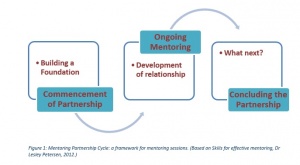Mentoring methods
| Foundation Skills | |
|---|---|
| Lecturer self-evaluation | |
| Mentoring for teachers | Objectives | What is Mentoring? | Mentoring methods | Summary | e-Activity | |
The mentoring arrangement is described by Petersen (2012) as a partnership cycle with three distinct stages:
- Commencement of partnership: Building a foundation;
- Ongoing mentoring: Development of the mentoring relationship; and
- Concluding the partnership: What next?
- 1. Commencement of partnership - Building a foundation
This stage requires the setting of ground rules including confidentiality agreements. Both parties can clarify expectations, and ideally develop a verbal or written agreement covering the timeline and logistics for meetings - where, when, and how often. Both the mentor and mentee need to decide on the purpose of the support, identify the mentee's goals, and establish how to build rapport, and develop a trusting relationship.
It is helpful to agree on the feedback process. For example, a collaborative arrangement could be set up where the mentee shares a Google document with the mentor who agrees to add feedback online. This type of shared document allows regular and timely contributions by both parties and facilitates speedy communication in between face-to-face or virtual meetings.
- 2. Ongoing mentoring - Development of the mentoring relationship
During the mentoring process meetings need to be focused and driven by the mentee. This stage works best when both sides have shared and collaborative responsibility for the process, and when issues are identified and discussed, and solutions sought. Both parties need to use reflective processes and prepare in advance for meetings, and not be afraid to deal with challenging situations. Also, achievements and successes need to be celebrated, goals revisited regularly and the mentees' progress evaluated.
- 3. Concluding the partnership - What next?
At this final stage, the achievements and successes of the mentee are documented, along with the outcomes of the mentoring process. The mentoring partnership may end or continue into a second period.
Hopefully, you can see that engaging in a professional mentoring process can be useful. Also, bear in mind that an understanding what contributes to effective mentoring, can assist you to develop skills that can be used in a similar arrangement with students. For example, during practical placements or projects.
Read the Five habits for effective mentors by Sanders et al. (2012). (Click on the image once you reach the website to download the booklet.)
|
References
- Billet, S. (2000). Journal of Workplace Learning, 12(7), 272-285.
- Petersen, L. (2013). Skills for effective mentoring. Wellington: Ako Aotearoa.
- Sanders, M., Smith, A., Norsworthy, B., Barthow, S., Miles, L., Ozanne, P. & Weydeman, C.. (2012). Five habits for effective mentors. Wellington: Ako Aotearoa. Retrieved from https://akoaotearoa.ac.nz/learning-dialogue-in-field-based-experiences
- Sanders, M., Smith, A., Norsworthy, B., Barthow, S., Miles, L., Ozanne, P. & Weydeman, C.. (2012). Ideas for training providers. Wellington: Ako Aotearoa. Retrieved from https://akoaotearoa.ac.nz/learning-dialogue-in-field-based-experiences
